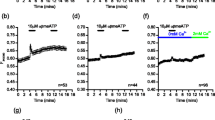Abstract
The antineoplastic drug mitoxantrone (MTX) elicits a fast nocytotoxic and nonimmunological histamine release from peritoneal and pleural rat mast cells. The non specific phosphodiesterase inhibitor isobuthylmethylxantine (1 mM) decreases the potency of MTX. Theophylline (10 mM) decreases both the potency and the efficacy of MTX-induced histamine secretion. The protein kinase C (PKC) activator, tetradecanoyl-phorbol-13-acetate (50 ng/mL), enhances the effect of MTX, whereas the non specific PKC inhibitor trifluoperazine (10 μM) exerts no effect.
Histamine release was also unaffected by substances acting on G-proteins, namely pertussis toxin (200 ng/mL), cholera toxin (300 mg/mL) and benzalkonium chloride (10 μg/mL). The inhibition of protein phosphatases 1 and 2A by okadaic acid (1 μM) does not modify the response. The results indicate that mitoxantrone elicits the exocytosis in mast cells by a mechanism similar to the parent compound adriamycine, but different to the polyamine compound 48/80.
Similar content being viewed by others
References
Weiss RB. Hypersensitivity Reactions. Sem Oncol 1992;19:458–77.
Ravetch JV. Fc Receptors: Rubor Redux. Cell 1994;78:553–60.
Diamant B. New insights into the mechanisms of histamine release from rat peritoneal mast cells. Chem Immunol 1990;49:142–72.
Mousli M, Bueb JL, Bronner C, Rouot B, Landry Y. Gprotein Activation — A Receptor-Independent Mode of Action for Cationic Amphiphilic Neuropeptides and Venom Peptides. Trends Pharmacol Sci 1990;11:358–62.
Arnaez E, Alfonso A, Estévez MD, Vieytes MR, Louzao MC, Botana LM. Effect of purification, theophylline and sodium fluoride on histamine release produced by antineoplastic drugs on rat mast cells. A distinctive mechanism of action for carboplatin. Biochem Pharmacol 1992;44:533–8.
Estévez MD, Vieytes MR, Botana LM, Study of the activation mechanism of adriamycin on rat mast cells. Agents Actions 1994;42:86–91.
Botana LM, Arnaez E, Vieytes MR, Alfonso A, Bujan MC, Louzao MC. et al. Non-immunological release of histamine from rat mast cells elicited by antineoplastic agents. Cancer Chemother Pharmacol 1992;29:495–8.
Riegel EA, Kaliner M, El HAN, Ferrans VJ, Kawanami O, Herman EH. Anthracycline-induced histamine release from rat mast cells. Agents Actions 1982;12:431–7.
Koeller J, Eble M. Mitoxantrone: a novel anthracycline derivative. Clin Pharm 1988:574–81.
Klugmann FB, Decorti G, Candussio L, Mallardi F, Grill V, Zweyer M, et al. Amelioration of 4′-epidoxorubicin-induced cardiotoxicity by sodium cromoglycate. Eur J Cancer Clin Oncol 1989;25:361–8.
Bartoli KF, Decorti G, Candussio L, Mallardi F, Grill V, Zweyer M, et al. Effect of ketotifen on adriamycin toxicity: role of histamine. Cancer Lett 1988;39:145–52.
Black DJ, Livingston RB. Antineoplastic drugs in 1990. A review. Drugs 1990;39:652–73.
Estévez MD, Vieytes MR, Louzao MC, Botana LM, Effect of okadaic acid on immunologic and non-immunologic histamine release in rat mast cells. Biochem Pharmacol 1994;47:591–3
Shore PA Fluorometric assay of histamine. Meth Enz XVII 1971:842–5.
MacGlashan D, Botana LM. Biphasic Ca2+responses in human basophils. Evidence that the initial transient elevation associated with the mobilization of intracellular calcium is an insufficient signal for degranulation. J Immunol 1993; 150:980–91.
Ui M. Pertussis toxin as a valuable proble for G-protein involvement in signal transduction. In: Moss J. Vaughan M., editors. ADP-ribosylating toxins and G-proteins. Insights into signal transduction. Washington: ASM 1990:45–79.
Alfonso A, Estévez MD, Louzao MC, Vieytes MR, Botana LM, Determination of phosphodiesterase activity in rat mast cells using the fluorescent cAMP analogue anthraniloyl cAMP. Cell Signal 1995;7:513–8.
Estévez MD, Alfonso A, Vieytes MR, Louzao MC, Botana LM. Study of the activation mechanism of human GRF (1–29)NH2 on rat mast cell histamine release. Inflamm Res 1995;44:87–91.
Penner R, Matthews G, Neher E. Regulation of calcium influx by second messengers in rat mast cells. Nature 1988;334:499–504.
Botana LM, MacGlashan D. Differential effects of cAMP-elevating drugs on stimulus-induced cytosolic calcium changes in human basophils. J Leukocyte Biol 1994;55:798–804.
Saeki K, Ikeda S, Nishibori M. Calcium requirement for the inhibition by theophylline of histamine release from mast cells. Life Sci 1983;32:2973–80.
Saito H, Okajima F, Molski TF, Shaafi RI, Ui M, Ishizaka T. Effect of cholera toxin on histamine release from bone marrow-derived mouse mast cells. Proc Natl Acad Sci USA 1988; 85:2504–8.
Aridor M, Traub LM, Sagi-Eisenberg R. Exocytosis in mast cells by basic secretagogues: evidence for direct activation of GTP-binding proteins. J Cell Biol 1990;111:909–17.
Gomperts BD, Hide I, Bennett JP, Pizzey A, Tatham P. Part VII. Secretory cell models: Intracellular signaling, second messengers, and exocytosis. The exocytotic reaction of permeabilized rat mast cells. An all-or-none response. Ann N Acad Sci 1994;710:217–31.
Botana LM, Alfonso A, Botana MA, Vieytes MR, Louzao MC, Cabado AG: Influence of protein kinase C, cAMP and phosphatase activity on histamine release produced by compound 48/80 and sodium fluoride on rat mast cells. Agents Actions 1992;37:1–7.
Ishizaka T, Conrad DH, Schulman ES, Sterk AR, Ko CG, Ishizaka K. IgE-mediated triggering signals for mediator release from human mast cells and basophils. Fed Proc 1984;43:2840–5.
Bueb JL, Mousli M, Landry Y, Bronner C. A pertussis toxinsensitive G protein is required to induce histamine release from rat peritoneal mast cells by bradykinin. Agents Actions 1990;30:98–101.
Heiman AS, Crews FT. Characterization of the effects of phorbol esters on rat mast cell secretion. J Immunol 1985;134:548–55.
Cohen P, Holmes CF, Tsukitani Y. Okadaic acid: a new probe for the study of cellular regulation. Trends Biochem Sci 1990;15:98–102.
Author information
Authors and Affiliations
Additional information
accepted by W. Lorenz
Rights and permissions
About this article
Cite this article
Estévez, M.D., Vieytes, M.R. & Botana, L.M. Mitoxantrone induces nonimmunological histamine release from rat mast cells. Inflamm Res 45, 113–117 (1996). https://doi.org/10.1007/BF02265162
Received:
Revised:
Accepted:
Issue Date:
DOI: https://doi.org/10.1007/BF02265162




